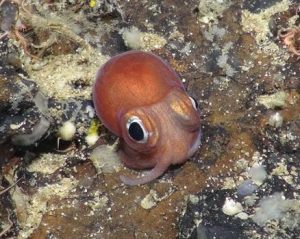Life in the Deep Sea is Mostly Mysterious

The deep sea covers around 65% of the planet’s surface, making it the largest habitat on Earth. Yet, this vast area remains largely unknown. The remoteness of the deep sea, which lies below 200 m, makes traditional ecological data collection methods extremely difficult. As a result, very little is known about the lives of deep sea creatures.
“This is the largest habitat on the planet, but we know very little about how it functions and how it may react to future changes,” says Michelle Taylor of Oxford University. “Humans are continuing to encroach on this habitat and that’s not going to change. We have to start thinking about how we’re going to manage this environment responsibly.”
A first step is focusing on population genetics – the comparison of genetic diversity within and between populations of individuals. This approach can help scientists gather basic ecological information on deep sea animals and model patterns of connectivity and genetic diversity.
With fellow Oxford University scientist Christopher Roterman, Taylor recently reviewed all the population genetics studies of deep sea invertebrates published to date. Their results highlight the disparity between our limited knowledge of deep sea ecology and the growing impact of humans on this habitat.
An Unknown World
Taylor and Roterman found 77 population genetics studies of deep sea invertebrates, covering just 115 species, over the last 30 years. These are meager numbers compared to the 25,000 named species inhabiting the deep sea (as well as numerous undiscovered species).

Most of the papers focused on commercial species at the shallower end of the depth range (200-1000 m). Only two studies looked at creatures that live deeper than 5000 m, an area accounting for a quarter of the planet’s seafloor.
Taylor and Roterman used what little data exists to characterize how populations of deep sea animals are connected over depth and distance. They found that populations at similar depths were well-connected over ranges of hundreds to thousands of kilometers. However, relatively small changes in depth could house separate populations of animals.
“You can travel just a few meters down in depth and the genetics will change dramatically,” says Roterman. “Many factors change with depth, like temperature, pressure, and oxygen availability, and these could be the drivers behind those genetic changes. It means there is a lot of hidden diversity with depth, and that has implications for how we manage the sustainable use of deep sea resources.”
Unlocking the Sea’s Secrets
With the cost and logistical challenges of collecting data from the deep sea, it might seem that it will remain mysterious. But Taylor and Roterman emphasize that technological advances like next-generation genetic sequencing mean that more genetic information can be extracted from fewer individuals – a potential game-changer for a field where specimen collection remains a major hurdle.

Taylor also cites less expensive and easier-to-use remote operated vehicles (ROVs) as a powerful tool for exploring the deep sea. Rather than the traditional method of sending a trawl down to the seafloor and then bringing it up to investigate its contents ten minutes later, ROVs allow scientists to observe the seafloor in real time.
“Technology is literally illuminating the deep sea in ways we’ve not seen previously,” says Taylor. “The robotics and engineering that go into getting there and seeing those animals living in a community together is actually one hell of an achievement.”
Preserving the Deep Sea
Despite its remoteness, human activities are encroaching on the deep sea. Pollution, fishing, climate change, and mining are all intensifying and affecting populations of deep sea creatures. There is growing awareness that the habitats and resources in the deep sea need to be sustainably managed, but more data is required to guide these actions.
“We are trying to understand how resilient deep sea populations are and how resilient we anticipate they could be under the increasing threats of climate change and other human impacts,” says Roterman.
The biggest issue is collecting the knowledge that could be used to responsibly manage the deep sea before we damage it too much.
“The exploitation is outpacing the exploration,” says Taylor. “And that’s worrying.”
Reference:
Taylor, M. L. and Roterman, C. N. (2017). Invertebrate population genetics across Earth’s largest habitat: The deep-sea floor. Molecular Ecology. doi: 10.1111/mec.14237.
